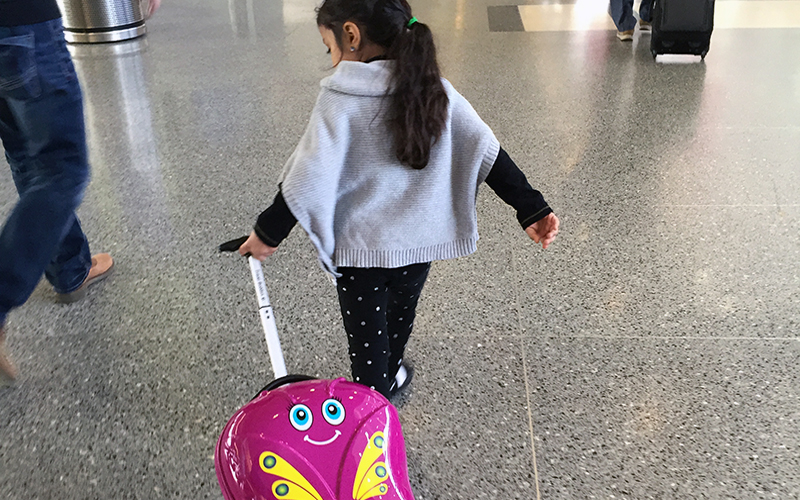
by guest blogger Andeep Singh, documentarian and television and Web video producer
Their fear is palpable as we board the airplane. My 5-year old walks down the aisle, pulling her pink suitcase, happily counting row numbers when a passenger gives me that look. All traveling parents know the look. It’s the look that says, “please, please, please don’t sit next to me with your spawn.”
Babies and kids get a bad rep when flying. In fact, children are ranked the most annoying problems to have on planes; above drunks, shrinking legroom, and even mechanical delays.
It’s a fact, babies cry. And older kids get antsy, forget they have limbs and inadvertently kick the seat in front of them. Sure there are some parents who ignore their kids’ terrible behavior and choose instead to put on their headphones, but most parents do whatever they can to entertain and discipline. Some conscientious parents even apologetically create ways to placate fellow passengers by offering sweets and booze, because no one likes that look.
But why are we as a society so very intolerant of kids who are behaving like, well, kids? How is it that grown adults are unable to find a little bit of patience within their hearts for the littlest of travelers? What happened to compassion? What happened to humanity? Did it get lost in the seat cushions as the airlines started charging per square inch?
A few days ago we flew back from Mexico and my daughter was delighted to learn she had a window seat. I settled into the middle seat and we waited to see who would join us in the aisle. Soon a very jittery millennial-type appeared. She was anxious and curt, not to mention slightly disheveled. Her words fell out of her mouth in one giant rambling sentence.
Millennial-type: “Hi I’m a very nervous traveler and I really need a window seat and my mom didn’t book me in the right seat and I really cannot sit in the aisle so will your daughter switch with me?”
At first I was taken aback. How dare she ask a kid to move out of her seat? Then I, like most adults, judged her. Did this young adult just blame her mom for the seat error? How entitled! I had decided that I didn’t want this anxious weirdo who had quite clearly missed her dose of Xanax, sitting next to us.
I think I may have rolled my eyes at her. Surely, not my finest moment. I then turned to my daughter and asked:
Me: “Would it be okay if this lady sat in the window seat?”
She looked at my quizzically.
Daughter: “Why?”
Me: “Well, she gets very scared when she flies on airplanes, and she needs to sit by the window to make her feel better.”
Then without a moment’s hesitation, my daughter responded:
Daughter: “Okay!”
That’s it!
No complaints. No eye rolling. No sighing. No mid-air fistfights that require the captain to turn the plane around and land in Gander, Newfoundland. (They always land in Gander, don’t they?)
Just like that, my 5-year-old got up and switched seats. Although, she really wanted the window, she was able to imagine herself in the girl’s position and realized someone else needed that seat more.
And there it was: compassion—real life human compassion on an airplane. And best yet, it came from a child! My child.
I too had just been schooled. I felt ashamed for how I had treated the anxious girl. But moreover it got me thinking.
Maybe adults need to sit next to children MORE often on flights instead of less. Maybe we all need to sit next to more types of people so that we can see beyond the annoyances.
Perhaps instead of believing that other people are here to simply make our lives difficult, we can finally start to see the positives in people: Busy yet well-intentioned parents, worried yet smart young adults, stressed yet kind professionals, and inquisitive yet bored children.
As air travel becomes increasingly painful and commoditized, perhaps we can take these small moments of time and finally see our fellow travelers for who they are… people from which to learn and grow. After all, isn’t that what travel is all about?
 Andeep Singh works at the Rodale Video Network and has produced nonfiction television, film, and digital video content for some of the biggest networks in the country, including ABC, NBC, PBS, CBC, and A&E. She recently completed producing her first feature documentary film, titled Living the Fantasy, which follows the lives of six high-stakes fantasy football players. Originally from the Great White North, Andeep has a serious case of wanderlust, is afflicted with perpetual food envy, and is mildly obsessed with the Vancouver Canucks hockey team.
Andeep Singh works at the Rodale Video Network and has produced nonfiction television, film, and digital video content for some of the biggest networks in the country, including ABC, NBC, PBS, CBC, and A&E. She recently completed producing her first feature documentary film, titled Living the Fantasy, which follows the lives of six high-stakes fantasy football players. Originally from the Great White North, Andeep has a serious case of wanderlust, is afflicted with perpetual food envy, and is mildly obsessed with the Vancouver Canucks hockey team.




No comments yet.